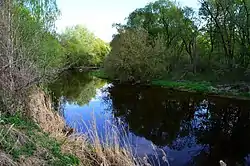Šušvė
Šušvė is a river in central Lithuania, a right (the longest) tributary of the Nevėžis river. It begins in Kelmė district municipality, 6 km (4 mi) southeast from Tytuvėnai. The river passes through Tytuvėnai and Sulinkiai Marshes and flows south through Radviliškis district municipality. Finally, Šušvė passes through Kėdainiai district municipality and flows into the Nevėžis near Graužiai village.
| Šušvė | |
|---|---|
 Šušvė River between Angiriai and Josvainiai | |
| Location | |
| Country | Lithuania |
| Physical characteristics | |
| Source | |
| • location | near Plekaičiai, Kelmė district municipality |
| Mouth | Nevėžis in Paliepiukai |
• coordinates | 55.1732°N 23.8317°E |
| Length | 134.6 km (83.6 mi)[1] |
| Basin size | 1,165.4 km2 (450.0 sq mi)[1] |
| Discharge | |
| • average | 6.22 m3/s (220 cu ft/s)[2] |
| Basin features | |
| Progression | Nevėžis→ Neman→ Baltic Sea |
| Tributaries | |
| • left | Beržė, Žiedupė |
| • right | Gomerta, Žadikė, Ažytė, Liedas, Lapskojis, Vikšrupis, Putnupys |
The width of the river valley is between 0.5 and 3 km. From December to March Šušvė is usually frozen. Dams were built at Vaitiekūnai and Angiriai (Angiriai Reservoir). The Šušvė Hydrological Sanctuary was established in 1992 to protect the lower courses of the river.[2]
The main towns and villages by the Šušvė river are Šiaulėnai, Pašušvys (Radviliškis municipality), Grinkiškis, Vaitiekūnai, Pašušvys (Kėdainiai municipality), Angiriai, Josvainiai.
Tributaries
The following rivers are tributaries to the river Šušvė (from source to mouth):
Etymology
The name Šušvė (or Šiušvė) comes from the root šuš- as in Lithuanian verbs šiušinti, šiušėti, šiaušti. All of them mean bouth 'to tousle' and onomatopoeicly allude to the sound of water.[3] According to another interpretation, the name Šušvė is related to the Finno-Ugric hydronym Sosva.[4]
References
| Wikimedia Commons has media related to Šušvė. |
- B. Gailiušis, J. Jablonskis, M Kovalenkovienė (2001). Lietuvos upės (in Lithuanian). Kaunas: Lietuvos energetikos institutas.CS1 maint: multiple names: authors list (link)
- Tarybų Lietuvos enciklopedija (in Lithuanian). 4. Vilnius: Vyriausioji enciklopedijų redakcija. 1988. p. 226-227.
- Vanagas, Aleksandras (1981). Lietuvių hidronimų etimologinis žodynas (in Lithuanian). Vilnius: Mokslas.
- Raymond Schmittlein. Toponymes finnois et germaniques en Lituanie. In: Onomastica. Paris, 1948. p. 97.